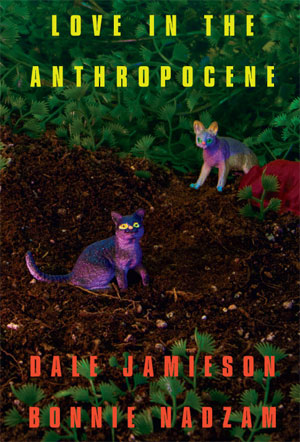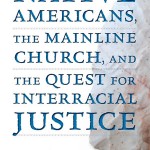“How will love arise in a world without nature as we have known it?” This is the central question of Love in the Anthropocene (OR Books, $18), a newly-released collection of two essays and five short stories jointly written by environmental philosopher Dale Jamieson and novelist Bonnie Nadzam.
Against the backdrop of a near-future earth that has been indelibly altered by humanity, Jamieson and Nadzam tell bittersweet stories of love: a father and daughter go on a fishing trip to an artificial park in which every tree, rock, stream, and fish are the product of technological design; two men rekindle a relationship while the city’s homeless are being deported to avoid rising sea levels; three female friends take a vacation from working at a refugee camp to enjoy the artificial pleasures of a domed city; a couple meets in a yoga class and carries on a virtual love affair; a blind date leads to an encounter with the world’s last living tiger.
Love in the Anthropocene has an agenda, but it is an agenda with more questions than answers. The authors address issues of environmental change “by telling stories and sharing meditations, not by issuing predictive declarations that are supposed to provide answers.” These carefully crafted vignettes, replete with moments of quiet beauty as well as deep unease, thoughtfully consider humanity’s effect on nature and nature’s effect on us.
At its heart, this is a book about what is real and about why we value that reality. What is the truth behind our words, our actions, our relationships, and our environment? What happens when our words mask hidden motivations and our emotions push us in conflicting directions? What are the ramifications of a reality composed of flawed imitations: genetically engineered food that doesn’t taste quite right, a stream bed that’s perfectly smooth, a skyline that’s a little too flawless? How do we relate to one another while living in an uncanny valley where nature is but a simulacrum of its former self?
Such problems may seem the stuff of speculative sci-fi, but in many real ways the future is already upon us. Love in the Anthropocene persuasively argues that we are already living in an epoch defined by humanity’s mark upon the planet and that we can no longer ignore the impact we are making on the natural world.
As I absorbed these stories I also wondered: what happens when technology continues to progress and the artificial becomes indistinguishable from the natural? Or when we eventually no longer remember what the “real” even was? Will we have lost something vitally important, because we are, at the very deepest level, inextricably linked to nature? Or will we continue to stumble through life and love as we always have, oblivious to the wider consequences of our actions and content to enjoy our — to borrow a phrase from the book — “narcissist’s playground”?
These are the sorts of questions that Love in the Anthropocene raises as it elegantly blurs the lines between literature, philosophy, and environmentalism. By exploring the liminal space between present and future, nature and technology, comfort and ennui, and beauty and pragmatism, Jamieson and Nadzam confront us with questions that don’t have easy answers — but I can think of few better ways of pondering such questions than by reading, and rereading, this book.
Find out more about Love in the Anthropocene →
 Dan Wilkinson
Dan Wilkinson
Dan is the Executive Editor of the Unfundamentalist Christians blog. He is a writer, graphic designer and IT specialist. He lives in Montana, is married and has two cats.













